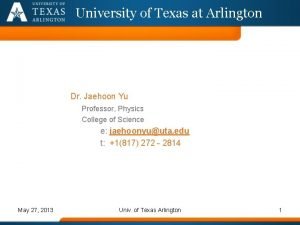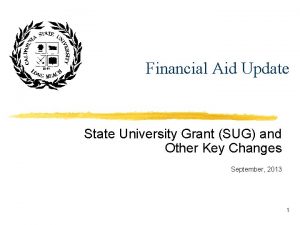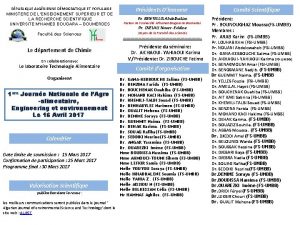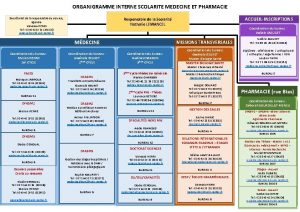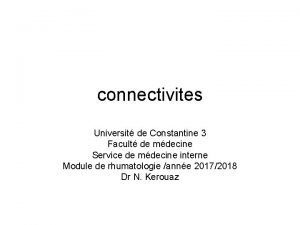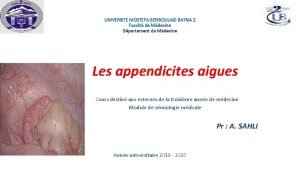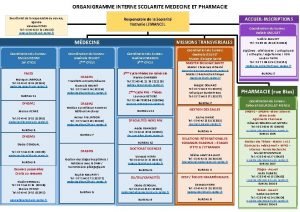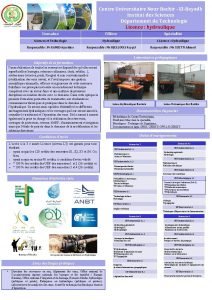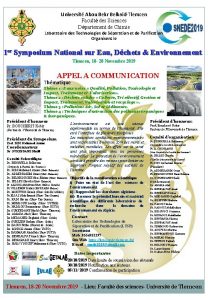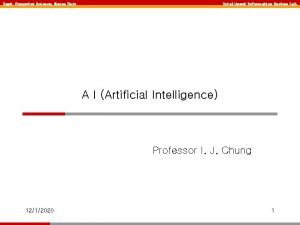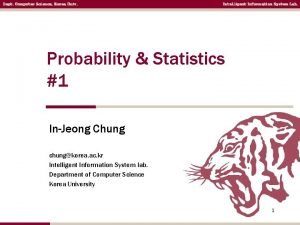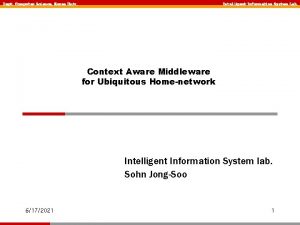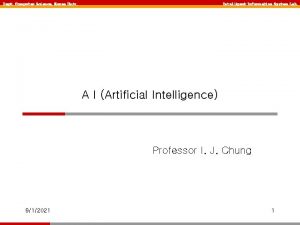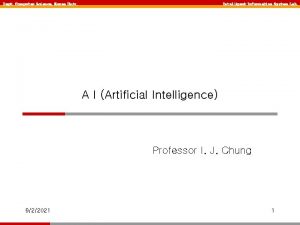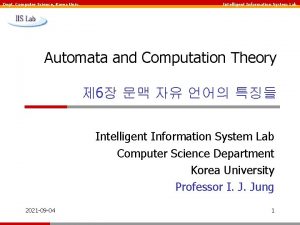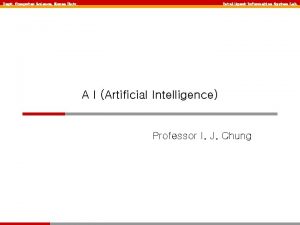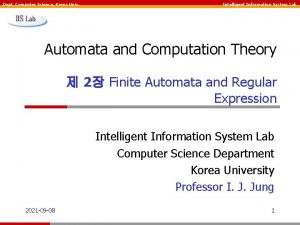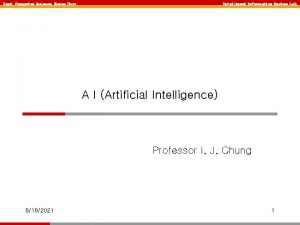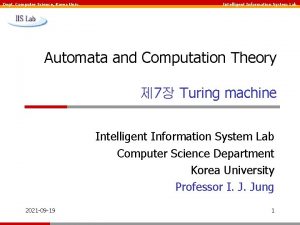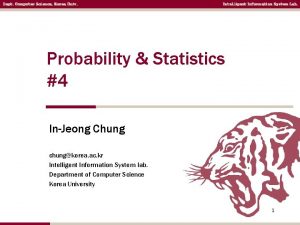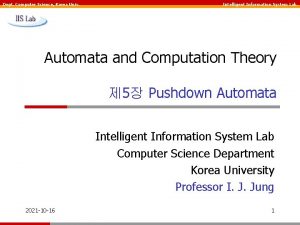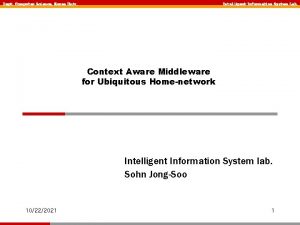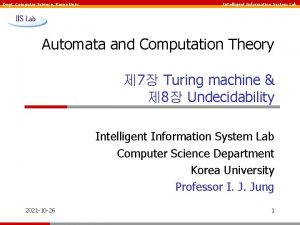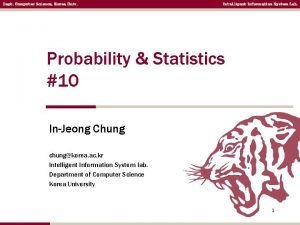Dept Computer Science Korea Univ Intelligent Information System





















- Slides: 21

Dept. Computer Science, Korea Univ. Intelligent Information System Lab. Probability & Statistics #5 In-Jeong Chung chung@korea. ac. kr Intelligent Information System lab. Department of Computer Science Korea University 1

Dept. Computer Science, Korea Univ. n E. g. Random variable ■ Likelihood Function Intelligent Information System Lab.

Dept. Computer Science, Korea Univ. Intelligent Information System Lab. ■ i. e. the sample mean is the reasonable estimation for (the population mean) n E. g. It’s known that a sample of 12, 11. 2, 13. 5, 12. 3, 13. 8 & 11. 9 comes from a population with the probability mass function :

Dept. Computer Science, Korea Univ. ■ Find the MLE for § Solution : Likelihood Function of n observations Intelligent Information System Lab.

Dept. Computer Science, Korea Univ. Intelligent Information System Lab.

Dept. Computer Science, Korea Univ. Intelligent Information System Lab.

Dept. Computer Science, Korea Univ. Intelligent Information System Lab. n E. g. ■ Find the MLE for ■ Soln : and

Dept. Computer Science, Korea Univ. n For the case of the estimator of Intelligent Information System Lab. , n E. g. 10 rats for the biomedical study rat is injected with cancer cells and drug to increase its survival time Survival time = 14, 17, 27, 18, 12, 8, 22, 13, 19 and 22 X ~ Exp Find the MLE of mean survival

Dept. Computer Science, Korea Univ. Intelligent Information System Lab. 9

Dept. Computer Science, Korea Univ. Intelligent Information System Lab. 連續函數的 分布 <<連續分布 : 確率密度函數가 連續函數>> n Simplest continuous distribution : uniform distribution ■ Probability mass function ■ E. g. Probability mass function for a random variable X on the interval [1, 3]

Dept. Computer Science, Korea Univ. Intelligent Information System Lab. ■ E. g. a conference room which can be reserved for no more than 4 hours - The length X of a conference has a uniform distribution on the interval [0, 4] - Probability mass function - Probability that any given conference lasts at least 3 hours

Dept. Computer Science, Korea Univ. Intelligent Information System Lab. n Note. Consider a random variable with a probability mass function of continuous function 1) Cumulative distribution function 2) Mean of continuous distribution 3) Variance of continuous distribution 12

Dept. Computer Science, Korea Univ. Intelligent Information System Lab. n Note. Mean & variance of uniform continuous distribution (warum? ) zu Studenten ! 13

Dept. Computer Science, Korea Univ. Intelligent Information System Lab. n Gauss distribution (Normal Distribution) Normal curves with 14

Dept. Computer Science, Korea Univ. Intelligent Information System Lab. n Note. (Proof) n The 1 st term on the right is times the area under a normal curve with mean 0 & variance 1, hence equal to The 2 nd term is 0. 15

Dept. Computer Science, Korea Univ. Intelligent Information System Lab. n Note. Standard normal distribution (標準正規分布) : The distribution of a normal random variable with i. e. 16

Dept. Computer Science, Korea Univ. Intelligent Information System Lab. n Gamma distribution (queuing theory / reliability problems. E. g. time to failure of component parts and electrical system. ) or (survival time : cf MLE – 1, eg. ) p. d. f (probability density function) 17

Dept. Computer Science, Korea Univ. Intelligent Information System Lab. n Note: Warum? 18

Dept. Computer Science, Korea Univ. Intelligent Information System Lab. n Exponential distribution (special form of Gamma dist. ) n Random variable with the probability mass function n Note: Exponential distribution is a special case of gamma distribution of n Note: Mean & variance of gamma distribution : 19

Dept. Computer Science, Korea Univ. Intelligent Information System Lab. ■ (Proof of note) ■ To find the variance, 20

Dept. Computer Science, Korea Univ. Intelligent Information System Lab. n E. g. Consider a system with component whose time in years to failure is given by T. The random variable T ~ Exp( ). i. e. the mean time failure. If 5 of these components are installed in different systems. P[ at least 2 are still functioning at the end of 8 years] = ? Soln: 21
 Korea institute of sport science
Korea institute of sport science What's your favorite lesson
What's your favorite lesson Intelligent information network
Intelligent information network Jaehoon yu
Jaehoon yu Cours médecine dentaire constantine
Cours médecine dentaire constantine Http:fsi-st univ-boumerdes-dz
Http:fsi-st univ-boumerdes-dz Sug grant
Sug grant Fs.umbb
Fs.umbb Celcat univ nantes
Celcat univ nantes Fs univ umbb
Fs univ umbb Univ constantine 3
Univ constantine 3 Pharmacie.univ-batna2
Pharmacie.univ-batna2 Scolarité médecine nantes
Scolarité médecine nantes Université elbayadh
Université elbayadh Prodoc univ nantes
Prodoc univ nantes Univ prof titel
Univ prof titel Univ tln moodle
Univ tln moodle Mail univ ouargla
Mail univ ouargla Licence spi poitiers
Licence spi poitiers (univ. caxias do sul) escolha a alternativa que completa
(univ. caxias do sul) escolha a alternativa que completa Loncapa ohio university
Loncapa ohio university Ent valenciennes
Ent valenciennes



